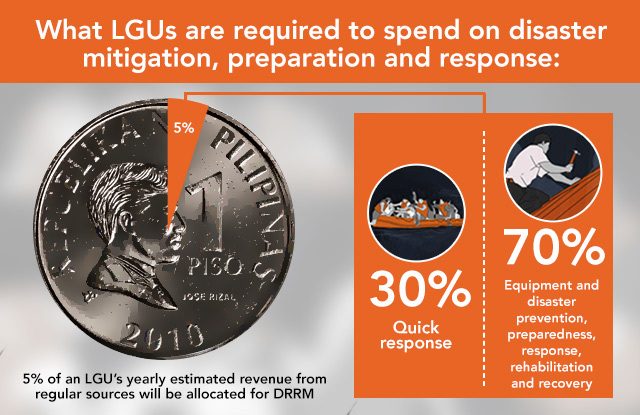SUMMARY
This is AI generated summarization, which may have errors. For context, always refer to the full article.

MANILA, Philippines – In times of calamities, where do we get money from?
The Philippine government has several funds to cushion impacts of disasters. Among these are:
- Local disaster risk reduction and management fund (LDRRMF)
- National disaster risk reduction and management fund (NDRRMF)
- People’s Survival Fund
- Special provisions in the General Appropriations Act
Under Republic Act No. 10121, the law provides that disaster management activities will be sourced from the DRRM fund, formerly known as “calamity fund.” (READ: TIMELINE: PH policies on climate change and disaster management)
Local disaster funds
RA No. 10121 mandated local governments to set aside 5% of their estimated revenue from regular sources for their disaster councils.
Of the 5% lump sum allocation, 30% is automatically allocated as Quick Response Fund which serves as a stand-by fund for relief and recovery programs.
The rest of the 70% can be used for pre-disaster measures. (READ: How do you use your local disaster funds?)

According to Republic Act No. 8185, an amendment to the Local Government Code, the local disaster fund can only be used in areas affected by disasters as determined by the local Sanggunian.
The implementing rules of RA No. 8185 also provides that the fund may be used to provide financial assistance to other LGUs.
The rule further states that allotment from the local disaster fund is to be released by the local budget officer within 24 hours from the occurrence of a calamity.
This is done after presentation of disbursement vouchers approved by authorities as supported by a Sanggunian resolution.
In the case of an actual calamity and pending declaration through a resolution, the local executive may draw cash advances from the general fund subject to auditing rules. However, these advances cannot exceed 50% of the designated local disaster fund.
National disaster fund
Likewise, the Philippine DRRM Act established a disaster fund on the national level to respond to urgent needs during emergency situations.
Funding allocation is determined in the national budget upon the approval of the President as recommended by the National Disaster Risk Reduction and Management Council (NDRRMC).
For 2016, a total of P38.9 billion has been allocated in the General Appropriations Act. Of the amount, quick response fund allocations are lodged under the budgets of the following implementing agencies:
- Department of Agriculture – P50 million
- Department of Education – P1 billion
- Department of Health – P510.5 million
- Department of National Defense – P200 million
- Office of Civil Defense – P530 million
- Department of Public Works and Highways – P1.3 billion
- Department of Social Welfare and Development – P1.325 billion
- Department of Transportation and Communications – P125 million
- Philippine Coast Guard – P75 million
- National Irrigation Authority – P500 million
- Bureau of Fire Protection – P75 million
- Philippine National Police – P75 million
These built-in funds do not need the approval of NDRRMC before being spent. According to DBM’s guidelines, budgets to agencies except PCG, BFP and PNP are comprehensively relased such that it can immediately enter into contracts, subject to procurement rule.
The special provision in the GAA also states that additional funding may be provided to the agencies’ QRFs if it reaches a critical level to be approval by the DBM.
Local governments may also request calamity fund assistance through their local DRRM councils, provided that they submit documents with the endorsement of the OCD regional director:
- Complete description/justification of the project
- Local DRRMC Damage Report/Calamity Impact Assessment Report/Work and Financial Plan (to include pictures)
- Sanggunian Resolution declaring the area under a State of Calamity/Imminent Danger and appropriating local counterpart for the project
- Certification by the Local Chief Executive thru a Sanggunian Resolution assuring that whatever amount will be provided by the Office of the President, the project will be completed/finished
- Certification and justification by the LCE concerned that funding requests chargeable against the Calamity Fund are emergency in character
- Certification by the Local Accountant or Finance officer that their Local Calamity Fund is already depleted/exhausted and/or non-availability of funding source other than the Calamity Fund
- Certification that the infrastructure being requested for funding support are not covered by insurance; and
- Pertinent documents may be required on a case to case basis
All requests are to be evaluated by the OCD. Only with the go signal from the President as recommended by the NDRRMC can the DBM release Special Allotment Release Order (SARO) and Notice of Cash Allocations (NCA) to implementing agencies or LGU.
Aside from the national disaster fund, People’s Survival Fund Act also provides financial assistance to projects that will address the impacts of disasters and climate change.
In the 2016 national budget, P1 billion was allocated under the People’s Survival Fund. Projects funded by the program is deliberated a board.– Rappler.com
Add a comment
How does this make you feel?
There are no comments yet. Add your comment to start the conversation.